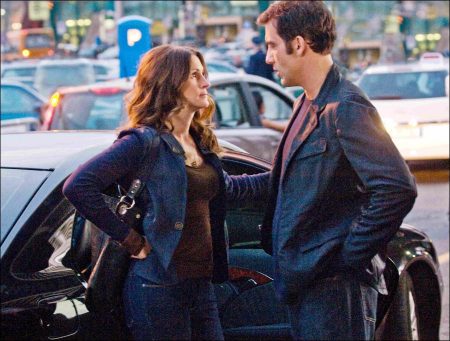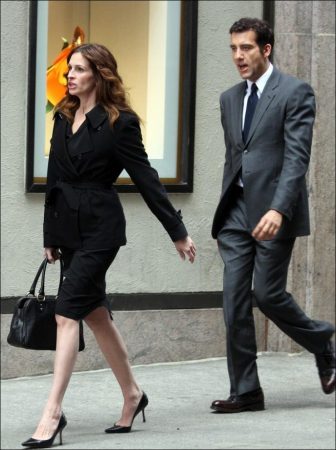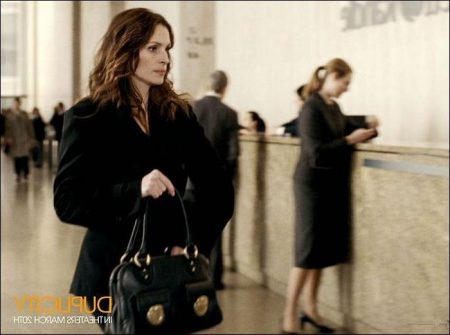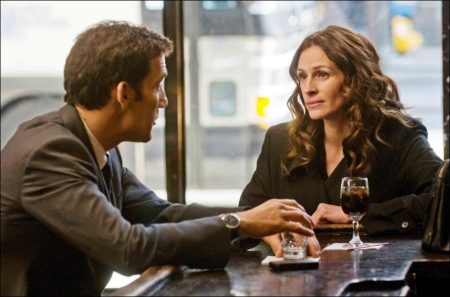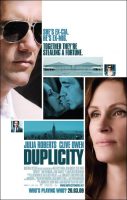Global Shoot: Rehearsal, Design and Locations
Rehearsal
Duplicity Movie Trailer. So his co-stars would be able to nail the tempo of their rat-a-tat dialogue prior to shooting, Gilroy spent a week rehearsing scenes with Roberts and Owen. “You’re prospecting all the time and desperate for things to happen that are not planned,” he says. “It’s happened here. The chemistry between Clive and Julia is really strong, and it’s smart.”
Roberts welcomed the extra week to prepare for the film and slip into, as Gilroy phrases, “the wardrobe of her character.” She also appreciated the luxury of time to rehearse for a role, versus jumping right into it. Both Roberts and Owen respected that Claire and Ray have prepared for this heist for years and were determined to have every look, nuance and minute detail in place. They will do anything not to risk losing $40 million. Indeed, it would take every minute of rehearsal time for the actors to prepare to deliver Gilroy’s lines just as rapid-fire as they were written.
To put him in the mind-set of the control freak Garsik, Giamatti was sent to an Upper East Side men’s barbershop for a taste of the pampered life one would expect a mogul to enjoy. Explains Jennifer Fox: “Paul is so down-to-earth, not the guy who would be doing this on his own. We wanted him to get the manicure and have a shave in one of those old-fashioned men’s clubs-to have that pristine, corporate feeling.”
The opening sequence of the film has our two CEOs racing toward one another. Wilkinson was game to rehearse the fight in a dance studio with Giamatti. To set the stage, Tully and Garsik have disembarked from their private jets, have left their entourages behind and launch into a playground brawl. To prepare for this scene-ultimately shot in an airline hangar in Upstate New York-the two men grappled around comically on wrestling mats. Recalls Fox, “We planned every move with a stunt coordinator, and we used padding on the ground. There’s this moment when Tom picks up Paul, and he’s in the air, then lands on the ground. Their fists are flying; it’s out of control and fantastic.”
Design
It was important to Gilroy for the competing companies to have a distinct look and feel. Burkett & Randle was designed to present an identity that was very clean and stark, because its counterintelligence agency was underground, dark and buzzing with activity and high-tech spy systems; it was built to feel like a clinical bunker. In contrast, the Omnikrom unit was more a collage of texture, pattern, layers and transparencies.
Says production designer Kevin Thompson of the steps he took with the filmmakers: “You start with very basic, rudimentary ideas, like Burkett & Randle is going to be white and minimal, and their theme color is going to be blue. The Omnikrom team is going to be the red team, and they are going to be much more high-tech with layers of texture and grays and no white or blue at all. Oddly enough, Burkett & Randle’s logo ended up being blue, and Omnikrom’s logo was red.”
Thompson has a high regard for Gilroy’s aesthetics.“Tony’s extremely visual and very specific in what he likes: clean lines, restful compositions and fairly masculine designs,” he says. “Because he’s a writer, he can articulate what he likes visually; it’s a real asset to the designer.”
Shooting on Location
Burkett & Randle and Omnikrom are both headquartered in Gilroy’s hometown of New York City, while the film’s flashbacks take us into Claire and Ray’s secret rendezvous cities-from, chronologically, Dubai, Rome and London to Miami, Cleveland and Zurich. Principal photography for Duplicity began in Manhattan, then the company moved to the Atlantis Resort in the Bahamas for one week of shooting. It spent the final week of production in Rome, where Claire and Ray first fell in love and began, as Gilroy puts it, “stealing little moments.” Thompson had the enviable job of creating sets in some of the most famous buildings and locations in the world.
About the decision to shoot in Manhattan, Thompson offers, “It was always important to have real New York streets and classic New York locations, but not shoot them in a traditional Hollywood way.” One of the earliest scenes in the film shot in Grand Central Station, which was filmed at the pedestrian level for a greater sense of urgency. Several iconic New York buildings were used for interior and exterior shots of the rival company’s offices. For example, the roofs of the MetLife Building and Rockefeller Center were used to capture establishing shots of the Big Apple. DP Elswit and his team were especially pleased to be among the first filmmakers to lens the city with the new Panavision G-Series lenses.
“Grand Central was important, as was the big shopping scene in Lord & Taylor where Clive finally catches up with Julia,” Thompson says. “Being on Fifth Avenue in midtown, Central Park, the Chase Manhattan Bank Building, the top floor of the Citicorp Building, Lever House, the Seagram Building…these are the most beautiful, classic pieces of architecture we have in the city, and we shot in them.”
One of the more challenging locations to secure was space in the Seagram Building. The production intended it to serve as the power center for the head of Burkett & Randle. Producer Kerry Orent explains: “The Seagram’s location allowed Tony to position Howard Tully’s office at the center of the Midtown Manhattan canyon of corporate and financial power. The location gave Tony the opportunity to present Tully’s office within a certain distance to his archrival’s Omnikrom building. At the time of filming, it was very difficult to find empty office space in midtown, especially in famous architectural icons like Seagram’s. After months of searching, Kevin Thompson found a rare, empty space in that building. With Tony’s support, Kevin transformed an unfinished space that had wires hanging down and Sheetrock falling over into a perfectly designed office for Tully.”
Filming Ray’s pursuit of Claire through Grand Central Station made the Seagram Building prep look like a walk through Central Park. Shares Orent of the experience of coordinating with everyone from the Metro North Transit Authority to NYPD: “At Grand Central, we had less than five hours to shoot a complicated scene with hundreds of extras…before thousands of Grand Central commuters started arriving. We were required to start at 4 a.m. on a Sunday morning. It was the only window of time that Metro North could allow us to have some control of the vast space. By 9 a.m., we hurried to complete the sequence. We couldn’t stop the trains from coming or tell travelers that they couldn’t pass through the station.
“It was a lot of planning for weeks in advance,” Orent continues, “but with a lot of cooperation and Tony’s willingness to work with our limitations, he designed an amazing shot that starts on the clock in Grand Central Station and comes down to reveal Clive discovering Julia.”
Additionally, New York served as a wealth of unexpected locations for our jet-setting spies. The interior of the hotels in London, Rome and Dubai were shot in the city, with establishing shots of those locales accomplished by second units.
The crew moved on to the Atlantis Paradise Island Resort in the Bahamas, where it filmed three of the script’s locations in one spot. In addition to the Atlantis scenes in which our spies seek answers from a very drunk Ronny Partiz at the baccarat table, the resort’s Ocean Club doubled for other script locales. This includes the Miami bungalow scene in which Ray and Claire agree she’ll work for Omnikrom (at the counterintelligence desk for Burkett & Randle)…as well as the pool scene at the American Consulate in Dubai (where our lovers first meet). Fortunately for the writer/director, the casino in which he ended up shooting was the exact location he’d written about.
Rome was the final stop in the production shoot. In this city, Claire and Ray reconnect-in a flashback sequence-three years after they first met in Dubai. The advance team spent months looking for ideal spots in which to lens, according to Orent. He recalls: “The locations that Tony selected in Rome were based on a long process of scouting and working with the Italian government to get the proper approvals to film in the old part of the city. One of our principal locations for filming was the plaza adjacent to the Pantheon. It is the perfect setting for the sequence where Clive discovers Julia walking across the plaza. It took a long time to secure this location. We were not sure that we would get a permit to film in the plaza because it is such a big tourist attraction.Our Italian production team spent months working with the government authorities to get approval to shoot there.”
Gilroy felt these exteriors needed to represent the classic, romantic places he fell in love with during his visits to the region. Designer Thompson elaborates: “We scouted at the Piazza Navona and the Pantheon, and we went into the Jewish ghetto. We wanted a romantic setting that started big and then goes through the alleyways and into a more intimate piazza, the Piazza Margana-the classic old section of the town. Tony loves it and fantasized about making a movie there, so it was where Clive and Julia had to have their scene.”
Though the crew shot extensively in Rome, the flashback scene in Claire and Ray’s grand Roman hotel suite was filmed at the James A. and Florence Vanderbilt Sloan Burden mansion in New York-now home to the all-girls school called the Convent of the Sacred Heart. The ballroom and anteroom of the mansion provided details reminiscent of the hotel suites that Thompson and Orent had scouted in Rome.
Fortunately, the production accommodated the extensive on-location shooting required to give Duplicity its depth and accuracy. Gilroy says of being able to shoot in Rome: “While you’re writing the script locations, you just write `Rome: exterior Pantheon,’ and you’re praying to God you’re going stay on the job until they go to shoot that scene.”
Dressing for War: The Costumes
A two-time Academy Award-winning costume designer, Albert Wolsky was charged with dressing the leads and setting a visual tone for the characters through their wardrobe. “Contemporary films are much harder than any period films for many reasons,” he explains. “My job is really about storytelling, with the adjunct being the costumes. In other days, it was easier to tell who a person was, what class they were and where they were coming from. But today, it’s totally eclectic. You can’t tell who’s rich, who’s poor; I can’t even tell who’s well dressed anymore.”
Since her unforgettable walk down Rodeo Drive in Pretty Woman, Roberts has shown remarkable sophistication in style. Her longtime collaborator on such films as The Pelican Brief, Runaway Bride and Charlie Wilson’s War, Wolsky designed the look of a gorgeous and brilliant spy who takes no prisoners.
Wolsky describes how he achieved the classic look Gilroy and the producers desired for the leads: “Tony wanted the film to be glamorous and sexy and, yet, we couldn’t have Julia Roberts walking around in strapless evening dresses. We had to find a way to do that whole look, which is really about not getting caught doing it. In Julia’s case, it was all very slick and formfitting. I felt from the beginning she should wear extremely high heels, which she didn’t mind. It gave her another stance, and it’s sexy.”
Wolsky believes that the first time the audience sees the characters is the most crucial time for clothing to be perfect. As he designs, he asks the questions of “What do you see first? Who are these people?” He notes, “Julia is totally corporate, and she’s a very black figure in the beginning. Clive is in this suit, shirt and tie-immaculate and in gray tones. The beginning of the film is full of grays and blacks. Tom Wilkinson is in black, and his whole world is in gray.”
Choosing the right color palette involved many conversations between Gilroy and Wolsky, as well as coordination with production designer Thompson on the color scheme he imagined for the rival companies. Thompson says, “In discussing color in the frame and the controlled use of color, Albert and I were coordinated with what the characters were wearing, what the walls looked like and how we could help each other. We discussed eliminating color from particular scenes, or making them lusher. The scenes have a real discipline to them.”
The colors and costumes (such as Owen’s impeccably tailored Armani suits) depended not only on location, but the time period of a particular scene-whether it was told in flashback or in present day. Explains Wolsky: “During one of the flashbacks, when Claire and Ray meet in Rome, I wanted color. Then we go forward to this present-day world, which has more grays, blacks and whites. Dubai, which is also a flashback scene, has a lot of color: lights, tans and beiges and summer. The story gave me a lot of control.”
Duplicity (2009)
Directed by: Tony Gilroy
Starring: Julia Roberts, Clive Owen, Billy Bob Thornton, Tom Wilkinson, Paul Giamatti, Rick Worthy, Carrie Preston, Ulrich Thomsen, Thomas McCarthy, Lisa Roberts Gillan, Kathleen Chalfant
Screenplay by: Tony Gilroy
Production Design by: Kevin Thompson
Cinematography by: Robert Elswit
Film Editing by: John Gilroy
Costume Design by: Albert Wolsky
Set Decoration by: George DeTitta Jr.
Art Direction by: Steve Carter
Music by: James Newton Howard
MPAA Rating: PG-13 language and some sexual content.
Distributed by: Universal Pictures
Release Date: March 20, 2009
Views: 207
